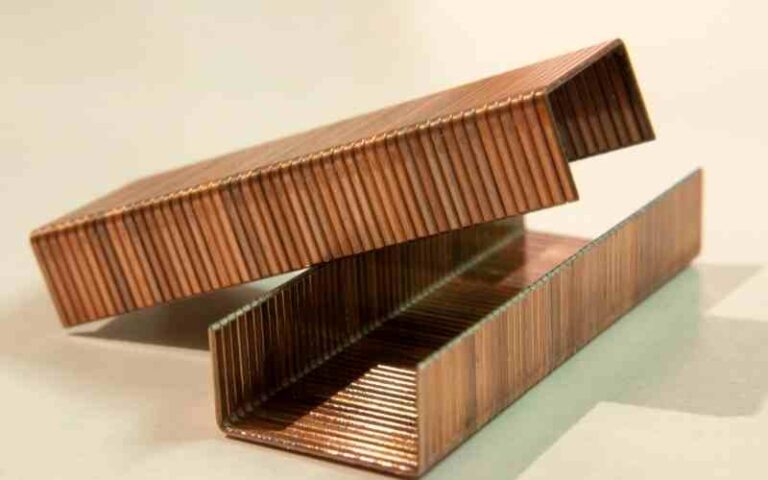Exterior trims contribute to the beauty of a house as they act as an additional protection layer against moisture.
However, the exterior trims will call for repair or new ones after years of use. Hence, if you decide to repair or change the exterior trims, you may be unfamiliar with the tools.
Even the nail sizes might be confusing, too, because all nails have different uses. So, which nail size is the best for exterior trim?
The choice of nail size depends on your exterior trim because their thicknesses vary. But, the suitable length for finishing trim nails ranges from 1- 4 inches, while the standard gauge ranges from 10-16 gauge size, depending on the trim’s thickness. But remember, a smaller gauge increases the nail’s strength.
Ready for a Roofing Quiz?
What Nails Should I Use For Exterior Trim?

The nails suitable for exterior trims are; stainless steel nails and aluminum trim nails. These nails are long-lasting and resist corrosion.
Not all nails are suitable for exterior trims since the trims will expose the nail to all weather conditions.
Thus, the choice of nail depends on the wood type, its thickness, and the nail’s resistance to corrosion.
So, for a successful exterior trim project, opt for aluminum and stainless steel nails because they never rust or react to pressure-treated woods. They are also strong and long-lasting.
#1. Stainless Steel Nails
Their outrageous resistance to corrosion attack outstands them among other nails. Therefore, they’re the best to consider for exterior trims.
Unlike other nail materials, stainless steel nails are safe for lumber, cedar, and redwood use. The reason is; that they drive into the woods without splitting them.
An 8d stainless steel nail of size 2 ⅜ inches is a good option when working on any pressure-treated wood.
Furthermore, there are paint-trim nails whose colors match the wood’s texture and create a good finish.
Additionally, stainless steel nails don’t react with wood or aluminum, causing no strain on the trim.
#2. Aluminum Trim Nails
Aluminum also has anti-rust properties, so it never oxide or rust upon exposure to moisture.
Also, these nails don’t react with cedar, redwood, and other treated woods. Besides, they’re also decorative.
Aluminum trim nails are the most suitable nail type for sidings because they don’t rust and lead to the decoloration of the trims.
However, I do not recommend aluminum trim nails for chemical exposure conditions. Exposure to chemicals will lead to the deterioration of aluminum.
Here is an outline of the similarities between aluminum and stainless steel nails.
| Features | Aluminum Steel Nails | Stainless Steel Nails |
|---|---|---|
| Corrosion-resistance | ✓ | ✓ |
| Longevity | ✓ | ✓ |
| Perfect for treated woods | ✓ | ✓ |
| Resistance to chemical attack | × | ✓ |
| Bending resistance | ✓ | ✓ |
What size Nail for 1×4 Exterior Trim?
Standard trim nails range from 10-16 inches. Also, the higher the gauge, the weaker the nails, but the lower the gauge, the stronger the nails.
In other words, the trim panel’s thickness determines the nail size to use. For clarification’s sake, here’s a hack on how to choose the right nail size.
Measure the thickness of the material you’re working on, and get a nail whose length is at least three times the thickness of the trim board.
You can use nailers instead of a hammer (a hammer is good too) to drive in the nails and ensure the right nailer for the job. And make a space of 6-8 inches between two nails.
Exterior Window Trim Nail Size
Using a brad nailer, you can use 1-inch brad nails to fasten the interior edge of the trim to the jamb.
For attaching the exterior edges of the trim to the frame or wall, use trim nails of size 2 ¼ inches. Ensure to use stainless steel nails since the trim is exterior.
Furthermore, a distance of roughly 6 inches must be between every two nails. Also, to avoid splitting the trim, ensure not to drive in the nails closer than 2 inches from the trim’s end.
However, different trim panels vary in thickness; hence, there’s no specific nail size for exterior window trims.
In that case, use a nail of length that’s at least three times the thickness of the trim panel you’re nailing.
For instance, assuming the thickness of the material is 2 ½ inches, the nail should be at least 7 ½ inches long.
Here’s a table showing various nail sizes and the trims they can work on without any split in the wood using the right nailers.
| S/N | Nail Length | Trims |
|---|---|---|
| 1 | 1-inch | Door trims and crown molding. |
| 21 ½ inch to 2 inchesShiplap and hardwood flooring perimeter. | ||
| 3 | 1 ¼-inch | Shoe molding, trim molding (over laminated floors). And plywood flooring. |
| 4 | Less than 2 inches (1-inch to 1 ⅝-inch preferably) | Paneling |
| 5 | Less than 1 ⅕ inches | For baseboards. |
Can You Use 16 Gauge Nails For Trim?
Due to their versatility, you can use 16 gauge nails for interior and exterior trims.
These nails are strong and have chisel-like points that eliminate wood splitting when using them. They are also corrosion-resistant owing to their galvanized nature.
16-gauge nails are suitable for door casing, window casing, baseboard trims, molding, paneling, and decorative trims.
The right 16-gauge nail size for outdoor projects ranges from ¾” to 2 ½”. However, some 16 gauge nails aren’t stainless and end up causing discoloration on the trims.
Hence, opt for the stainless steel nails because even on treated woods, they are intact. For best results, drive the nails in with 16-angled finish nailers.
All 16 gauge nails are ideal for all crown molding, cabinets, baseboard, and framing projects.
Types of Nails For Exterior Trim
Only strong nails with high corrosion resistance and durability are suitable for exterior trims.
Hence, opt for stainless steel and hot-dipped galvanized nails for any exterior projects.
Let’s delve into more information on these nails.
#1. Hot-dipped Galvanized Nails
These nails are highly resistant to corrosion. While producing these nails, the Manufacturers dipped the nails into hot molten zinc. Thus, a thick zinc layer covers them to prevent corrosion.
These nails can work for nearly all outdoor projects, including structures made from cedar and pressure-treated woods that corrode wood. Although, it can’t resist chemical attacks.
Hot-dipped galvanized nails are more reliable than electro-galvanized nails in corrosion resistance.
Electro-galvanized nails have a very thin layer of zinc which could eventually deteriorate after some time, unlike the hot-dipped nails with a thick zinc layer as a coating.
#2. Stainless Steel 304
Consider stainless steel nails if you need nails that guarantee resistance to corrosion attack.
Stainless steel nails have no coating but contain a mixture of anti-corrosion substances. The number 304 denotes the proportion of the alloy in it (18% Chromium and 8% Nickel).
Nearly all exterior woodworks require this nail type owing to its rust resistance and durability.
Although this stainless steel grade has a high melting point, it can’t resist chemicals because it will react with them (e.g., salts).
#3. Stainless Steel 316
This stainless steel grade is superior to all trim nails. 316 steel is a mixture of a handful of anti-rust elements, including 10% Nickel, 16% Chromium, and 2% Molybdenum.
As a result of this combination, this type of nail can withstand any unfavorable condition, including a chemical attack.
Related: Can You Use PVC Trim Inside?
Final Thoughts
Various nails have different purposes, and the nail size for interior trims might be unsuitable for exterior trims.
Also, the nail size depends solely on the trim’s material. If you’ll be working on a thick trim, use nails of lower gauges, while nails of higher gauges are the best for thicker trims.






